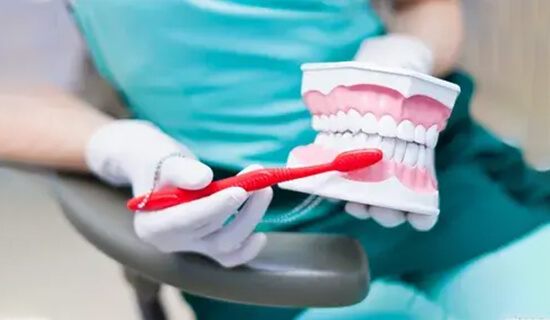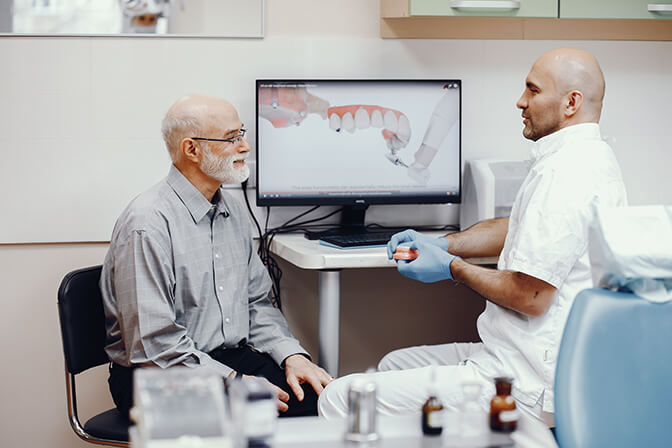Cleaning & Prevention
Routine Dental Check UPS & Preventative Dental Care
A preventive program is a cooperative effort by the patient, dentist, and dental staff to preserve the natural dentition and supporting structures by preventing the onset, progress, and recurrence of dental diseases and conditions.
Preventing dental disease starts at home with good oral hygiene and a balanced diet. It is continued in the dental office by the efforts of your dentist and dental hygienist to promote, restore, and maintain your oral health.

Prevention also includes regular dental exams, cleanings, and x-rays. Sealants and fluoride are also great preventive treatments that help protect the teeth.
Prevention helps avoid serious and costly dental problems and is the key to having a healthy, confident, beautiful smile.
Dental Exams & Cleanings
A comprehensive dental exam will be performed by your dentist at your initial dental visit. At regular check-up exams, your dentist and hygienist will perform the following:
Professional Dental Cleaning
Professional dental cleanings (dental prophylaxis) are performed by Registered Dental Hygienists. Your cleaning appointment will include a dental exam and the following:
Digital X-Rays
Digital radiography (digital X-ray) is the latest technology used to take dental X-rays. This technique uses an electronic sensor (instead of X-ray film) that captures and stores the digital image on a computer. This image can be instantly viewed and enlarged, helping the dentist and dental hygienist detect problems more easily. Digital X-rays reduce radiation 80-90% compared to the already low exposure of traditional dental X-rays.
Dental X-rays are essential, preventative, diagnostic tools that provide valuable information not visible during a regular dental exam. Dentists and dental hygienists use this information to safely and accurately detect hidden dental abnormalities and complete an accurate treatment plan. Without X-rays, problem areas can go undetected.
Dental X-Rays may reveal
Detecting and treating dental problems at an early stage can save you time, money, unnecessary discomfort, and your teeth!
We are all exposed to natural radiation in our environment. Digital X-rays produce a significantly lower level of radiation compared to traditional dental x-rays. Not only are digital X-rays better for the health and safety of the patient, they are faster and more comfortable to take, which reduces your time in the dental office. Also, since the digital image is captured electronically, there is no need to develop the X-rays, thus eliminating the disposal of harmful waste and chemicals into the environment.
Even though digital X-rays produce a low level of radiation and are considered very safe, dentists still take necessary precautions to limit the patient’s exposure to radiation. These precautions include only taking those X-rays that are necessary, and using lead apron shields to protect the body.
The need for dental X-rays depends on each patient’s individual dental health needs. Your dentist and dental hygienist will recommend necessary X-rays based upon the review of your medical and dental history, a dental exam, signs and symptoms, your age, and risk of disease.
A full mouth series of dental X-rays is recommended for new patients. A full series is usually good for three to five years. Bite-wing X-rays (X-rays of top and bottom teeth biting together) are taken at recall (check-up) visits and are recommended once or twice a year to detect new dental problems.
Fluoride Treatment
Fluoride is the most effective agent available to help prevent tooth decay. It is a mineral that is naturally present in varying amounts in almost all foods and water supplies. The benefits of fluoride have been well known for over 50 years and are supported by many health and professional organizations.
Fluoride Treatment
Topical fluoride strengthens the teeth once they have erupted by seeping into the outer surface of the tooth enamel, making the teeth more resistant to decay. We gain topical fluoride by using fluoride containing dental products such as toothpaste, mouth rinses, and gels. Dentists and dental hygienists generally recommend that children have a professional application of fluoride twice a year during dental check-ups.
Systemic fluoride strengthens the teeth that have erupted as well as those that are developing under the gums. We gain systemic fluoride from most foods and our community water supplies. It is also available as a supplement in drop or gel form and can be prescribed by your dentist or physician. Generally, fluoride drops are recommended for infants, and tablets are best suited for children up through the teen years. It is very important to monitor the amounts of fluoride a child ingests. If too much fluoride is consumed while the teeth are developing, a condition called fluorosis (white spots on the teeth) may result.
Although most people receive fluoride from food and water, sometimes it is not enough to help prevent decay. Your dentist or dental hygienist may recommend the use of home and/or professional fluoride treatments for the following reasons:
Remember, fluoride alone will not prevent tooth decay! It is important to brush at least twice a day, floss regularly, eat balanced meals, reduce sugary snacks, and visit your dentist on a regular basis.
Oral Cancer Exam
According to research conducted by the American Cancer Society, more than 30,000 cases of oral cancer are diagnosed each year. More than 7,000 of these cases result in the death of the patient. The good news is that oral cancer can easily be diagnosed with an annual oral cancer exam, and effectively treated when caught in its earliest stages.
Oral cancer is a pathologic process which begins with an asymptomatic stage during which the usual cancer signs may not be readily noticeable. This makes the oral cancer examinations performed by the dentist critically important. Oral cancers can be of varied histologic types such as teratoma, adenocarcinoma and melanoma. The most common type of oral cancer is the malignant squamous cell carcinoma. This oral cancer type usually originates in lip and mouth tissues.

There are many different places in the oral cavity and maxillofacial region in which oral cancers commonly occur, including
It is important to note that around 75 percent of oral cancers are linked with modifiable behaviors such as smoking, tobacco use and excessive alcohol consumption. Your dentist can provide literature and education on making lifestyle changes and smoking cessation.
When oral cancer is diagnosed in its earliest stages, treatment is generally very effective. Any noticeable abnormalities in the tongue, gums, mouth or surrounding area should be evaluated by a health professional as quickly as possible. During the oral cancer exam, the dentist and dental hygienist will be scrutinizing the maxillofacial and oral regions carefully for signs of pathologic changes.
The following signs will be investigated during a routine oral cancer exam:
The oral cancer examination is a completely painless process. During the visual part of the examination, the dentist will look for abnormality and feel the face, glands and neck for unusual bumps. Lasers which can highlight pathologic changes are also a wonderful tool for oral cancer checks. The laser can “look” below the surface for abnormal signs and lesions which would be invisible to the naked eye.
If abnormalities, lesions, leukoplakia or lumps are apparent, the dentist will implement a diagnostic impression and treatment plan. In the event that the initial treatment plan is ineffective, a biopsy of the area will be performed. The biopsy includes a clinical evaluation which will identify the precise stage and grade of the oral lesion.
Oral cancer is deemed to be present when the basement membrane of the epithelium has been broken. Malignant types of cancer can readily spread to other places in the oral and maxillofacial regions, posing additional secondary threats. Treatment methods vary according to the precise diagnosis, but may include excision, radiation therapy and chemotherapy.
During bi-annual check-ups, the dentist and hygienist will thoroughly look for changes and lesions in the mouth, but a dedicated comprehensive oral cancer screening should be performed at least once each year.
